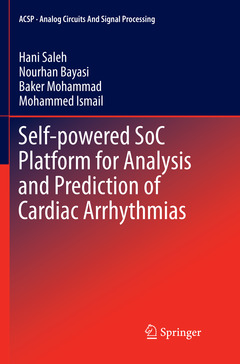Description
Self-powered SoC Platform for Analysis and Prediction of Cardiac Arrhythmias , Softcover reprint of the original 1st ed. 2018
Analog Circuits and Signal Processing Series
Authors: Saleh Hani, Bayasi Nourhan, Mohammad Baker, Ismail Mohammed
Language: English
Subjects for Self-powered SoC Platform for Analysis and Prediction of...:
105.49 €
In Print (Delivery period: 15 days).
Add to cartPublication date: 08-2018
Support: Print on demand
105.49 €
In Print (Delivery period: 15 days).
Add to cartPublication date: 11-2017
Support: Print on demand
Description
/li>Contents
/li>Biography
/li>Comment
/li>
This book presents techniques necessary to predict cardiac arrhythmias, long before they occur, based on minimal ECG data. The authors describe the key information needed for automated ECG signal processing, including ECG signal pre-processing, feature extraction and classification. The adaptive and novel ECG processing techniques introduced in this book are highly effective and suitable for real-time implementation on ASICs.
Hani Saleh is an Associate professor of electronic engineering at Khalifa University (KU), he joined KU since Jan, 2012. He is a co-founder and an active member in KSRC (Khalifa University Research Center) where he leads a project for the development of wearable blood glucose monitor SOC and a mobile surveillance SOC and safe exercise monitoring device. Hani published 90 articles in peer-reviewed journals and conferences, he has 8 issued US patents and 9 pending patent applications. Hani has a total of 19 years of industrial experience in ASIC chip design, microprocessor design, DSP core design, graphics core design and embedded system design. His experience spans DSP core design, microprocessor peripherals design, microprocessors and graphics core deign. Prior to joining Khalifa University he worked as a Senior Chip Designer (Technical Lead) at Apple incorporation; where he worked on the design and implementation of Apple next generation graphics cores for its mobile products (iPad, iPhone, …etc.), prior to joining Apple, he worked for several leading semiconductor companies including Intel (ATOM mobile microprocessor design), AMD (Bobcat mobile microprocessor design), Qualcomm (QDSP DSP core design for mobile SOC’s), Synopsys (a key member of Synopsys turnkey design group where he taped out many ASICs and designed the I2C DW IP included in Synopys DesignWare library), Fujitsu (SPARC compatible high performance microprocessor design) and Motorola Australia (M210 low power microprocessor synthesizable core design).
Nourhan Bayasi (M’13) received the B.S. degree in electrical and computer engineering from the Khalifa University of Science, Technology and Research, Abu Dhabi, United Arab Emirates, in 2013, where she is currently pursuing the M.S. degree in electrical and computer engineering. Her research project focuses on system-on-chip design and implementation of a fully integrated wearable biomedical system. Her curren
Provides a full overview of ECG signal processing basics and contemporary advances in the field
Introduces a new set of novel ECG signal features for automated ECG signal analysis;
Enables readers to invent new ECG signal features and determine if they can be effective in predicting or diagnosing cardiac arrhythmias and related disorders
Demonstrates results, supported by silicon validation and real-chip tape-outs
These books may interest you

Ambulation Analysis in Wearable ECG 105.49 €



